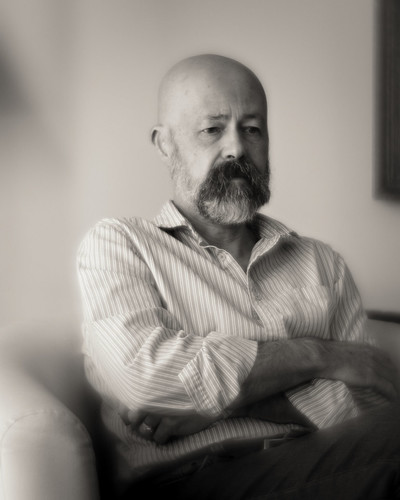As I continue to consider soft focus Pictorialist effects including lenses, processes, and printing, I thought it might be worthwhile to explore for a moment how to emulate early film emulsions.
At the dawn of photography emulsions were sensitive to blue light only. This is why skies in many images from the 1800's were white. This is why skin imperfections could be rather prominent.
By the start of the 20th century film became available that could record a broader spectrum of light. These were called "pan chromatic", as in sensitive to all colors. What's interesting to me is that these early film types couldn't see all colors equally. There were subtle differences in gray recording for different colors of exact same intensities.
Late in film history and before the time digital sensors, black and white film could "see" all colors fairly equally. If you took a picture of red, green, and blue values of exactly the same intensity, film would record them at the exact same level of gray.
This background is important if one wishes to try and accurately reproduce Pictorialist images.
I know I've said it before, but it bears repeating as color sensitivity of the recording medium had a important influence on how early photographs were made.
Returning to the primary object of this series of posts, the Pentax 85mm f/2.2 Soft, here is what I have thus-far learned.
This is not a general purpose lens. It appears this lens was designed for close-up and portraiture work. Period.
While the aperture controls in a very broad sense the level of under-corrected spherical aberration (veiling softness), it's more complex than just that.
It's blastedly difficult to use this optic on subjects beyond a medium/portraiture distance due to the way a sharper central region appears in the middle of what can look like a coke bottle bottom of softness around the edges as the aperture is stopped down. The effect becomes particularly apparent and troublesome as the focus approaches infinity.
Image processing can be used to help reveal the underlying "sharpness" of the lens by increasing overall and with digital image processing tools, local contrast. In early photography history these things were very difficult to control.
In summary of my current understanding of how best to use the Pentax 85mm f/2.2 Soft, from image capture through to image processing, there appears to be no simple, single answer on how to achieve success. It seems to me that a photographer would be best served to build a matrix of subject distance, aperture (including 1/2 stop settings), and image processing based on personal experience, study, tastes, and desired final image presentation.
As in the previous portraiture distance blog entry, I used myself as the subject. It's darned difficult to find or hire decent help these days. The modeling industry has changed significantly since we moved to Europe. It wouldn't surprise me to learn that cell-phones, and now AI have taken their toll on the old practice of modeling.
So as to not scare the women and horses, viewer discretion is advised.
Setup ~
- Camera -
- Sony A7, 100ISO, 2sec timer, "A" mode, +1EV
- Lens -
- Pentax 85mm f/2.2 Soft at f/4
- Bogen tripod
- RawTherapee -
- Global contrast increased by image to taste
- Local Contrast increased by image to taste
- B&W Channel Mixer filters
- Red
- Blue
- Blue-Green
Image Processing Comparison ~
As always, click on the image and enlarge to 100percent to see whatever there is to be seen.
Pentax 85mm f/2.2 Soft at f/4
B&W Channel Mixed Red Filter
Local Contrast enhanced
Pentax 85mm f/2.2 Soft at f/4
B&W Channel Mixed Blue Filter
Local Contrast enhanced
Of course, if I were to try and fully emulate wet-plate collodion or tin-type images I could raise the skin tones. I would need to be sensitive to the colors in the other parts of the scene, too. So it's worth studying carefully the tonal ranges of early Pictorialist images and to take these tones into account.
Pentax 85mm f/2.2 Soft at f/4
B&W Channel Mixed Blue-Green Filter
Local Contrast enhanced



No comments:
Post a Comment